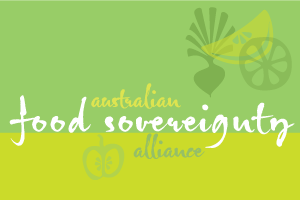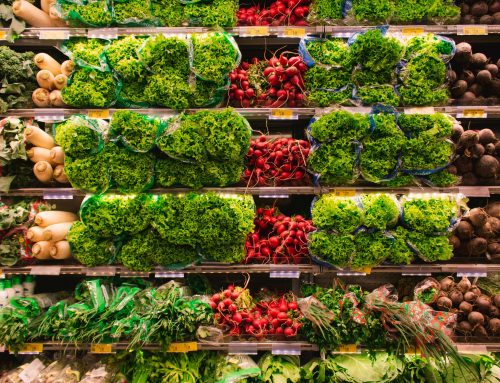…by Jane Dixon, Ruth Beilin, Bronwyn Isaacs, Nick Rose, Michael Santhanam-Martin and Michelle Young
Members of the Australia and New Zealand Agri-Food Research Network
May, 2011
In a context of the Queensland floods and cyclone and the floods in Victoria, many analysts have been asking questions about Australia’s food security. These severe weather events, which have destroyed the capacity of hundreds of fruit growers and pastoralists to deliver food for at least a season, have understandably overshadowed several significant policy decisions which will have long term consequences for Australia’s food producers and consumers.
Over the last six months, the national government has disappointed a wide spectrum of groups with its food security initiatives. The first was a narrowly constituted National Food Policy Working Group to advise the federal Minister of Agriculture on the food and farming sector’s priorities. Then, Australia’s Biosecurity Services Group announced that it would permit the importation of apples from China because it was satisfied that the produce would not pose any biosecurity risk. More recently, Biosecurity Australia has alerted the nation’s fruit growers that it will accept New Zealand’s standard orchard practices as Australia’s quarantine standard when it comes to its decision to import NZ apples. In the context of Australia’s free trade obligations, once biosecurity concerns have been satisfied we must accept these imports. This decision pits immediate economic gains against national bio-diversity risks given the presence of bacterial fire blight in New Zealand orchards.
With news that Australia’s natural disasters would drive up food prices by 50%, the decision to expand imported fruit supplies – especially as they could be considerably cheaper than the domestic commodities – seems a sound decision. By diversifying food sources, Australia is apparently contributing to its short term food system resilience.
The decision sits comfortably too with those concerned about a global ‘food supply crisis’ of possibly larger proportions than the 2008 crisis which saw grain feeds as well as human foods increase in price and scarcity. This spectre has led commentators to urge countries to embrace free trade, cautioning against protectionist moves or food self-sufficiency policies (see Alan Dupont, in the Sydney Morning Herald 10 January).
Not surprisingly, not all are convinced by the logic of permitting cheaper, but otherwise equivalent, foods into the country if it means weakening the viability of Australian food producers who will be needed as the global trade in food is impeded by other crises in inputs critical to food production, including energy and fertilisers..
Apple and Pear Ltd (APAL) – an industry body representing commercial apple & pear growers – has argued that while accepting Chinese apples might constitute free trade, it does not guarantee fair trade or trade in the nation’s long-term interest, a position certainly supported by the orchardists we work with in the Sydney Basin. They say that importing apples from China, New Zealand and possibly this year, from the US, is a death blow: for their families, their industry and for Sydney consumers wanting fresh fruit grown in Australia. Of the 80 orchards in the Bilpin area that flourished in the 70s and 80s, now 12 are left. These farmers say their income is so low (some averaging 50c a kilo) that they have had to cut production in order to control their losses and increasing debts. The orchardists attribute their low incomes to their need to sell to the supermarket duopoly (who buy only those apple varieties that they can store for up to a year) combined with increasing costs of inputs like water, fertilisers and energy. Where the orchards are located on prime urban real estate, the land taxes have also escalated. Production has been cut by up to 60 percent, even though in the same interviews some orchardists say they have the growing conditions to substantially increase volumes.
While Australia can use food imports to augment local supplies and to keep down food prices and inflation in the immediate term, Australia is not as food secure as governments assume. Drawing on the research presented at the recent 17th annual conference of the Australia and New Zealand Agri-food Research Network, we outline 6 key dynamics that undermine current assumptions about what is possible.
- While Australia exports 60% of its agricultural produce, and could re-divert this for domestic consumption, there is only so much meat, wheat, processed dairy and wine (our surplus commodities) that the population can consume
- Australia is unlikely to be able to continue to significantly improve plant food and animal feed yields on existing lands through the adoption of new technologies. With every passing year, the natural eco-system deteriorates further through soil volume loss, soil quality loss, prolonged drying and other extreme weather events affecting water quality. For example, Australian soils have suffered a 300% loss in organic matter (carbon content) over the course of the 20th century, and as much as three-quarters of Victoria’s soils are suffering from serious structural decline.
- In addition, the current food production system is highly dependent on fossil fuel energy and phosphorus fertilizers, both non-renewable resources now entering a period of declining availability and thus affordability. Market-driven responses to the early onset of peak oil, such as the current ‘coal-seam gas rush’, is threatening to further undermine our agricultural lands by contaminating groundwater tables, especially the Great Artesian Basin, with a cocktail of toxic chemicals used in the highly destructive ‘fracking’ process
- Food safety risks in our food supply nations – bacterial and other contamination and the spread of zoonoses (Avian flu) – further undermines supply chain stability as well as posing new threats to Australia’s domestic industries
- Australia’s increasing reliance on imported fruit and vegetables, which are an essential part of ‘good nutrition’, poses food security risks in a context of severe weather events and geo-political insecurity in our countries of supply (China, Thailand, South America), not to mention the importation of bio-security risks as mentioned above
- Looking after the health and well-being of Australian producers has to become a priority: those with poor health and low incomes are more likely to leave the land, be less productive and be less innovative in the face of climate change and other challenges. Five Australian farmers leave the land every day and rates of rural suicide and depression are double the national average: there is a silent rural crisis in Australia and this must be urgently remedied. For each 300 mm of rain loss, we can attribute an 8 per cent increase in farmer suicide. Victorian data show that for the last 40 years, farmers have had to make productivity improvements of 3% per annum: yet we have rising costs of production and falling farm gate prices, which is not helped by adding equivalent imported produce to the Australian food supply.
We suggest that the Australian government needs to significantly improve what it has begun in relation to constructing a national food policy. We recommend these three refinements to what is on offer as an important starting point.
- A more systematic engagement of stakeholders: A resilient food system requires diversity of production forms and supply chain arrangements: from those managed by transnational food corporations to backyard vegetable gardeners. The seeds of such a diverse and decentralised food system are already in place in Australia in the form of community gardens, community-supported agriculture, farmers’ markets and local food networks. Like the Public Health Association of Australia, we are concerned about the voices which appear to have been sidelined in the constitution of the new food working body, including public health (encompassing both human and environmental health). We would add to the group those representing small to medium urban and regional farmers, and those spearheading relevant small to large scale community-based initiatives.
- A concerted effort to unite policies affecting food systems. We would question why the Australian government has separate initiatives underway in the areas of food, energy and climate change. According to the International Energy Agency, peak oil occurred in 2006,, meaning that available energy supplies relevant to food systems have become even more expensive whether here or China or elsewhere. It is not too late to build upon the logic of a recent UK government Foresight Report – http://www.bis.gov.uk/assets/bispartners/foresight/docs/food-and-farming/11-546-future-of-food-and-farming-report.pdf -on farming and food policy that concluded: “Addressing climate change and achieving sustainability in the global food system need to be recognised as dual imperatives. Nothing less is required than a redesign of the whole food system to bring sustainability to the fore”. We would add that energy and population pressures are additional imperative which need simultaneous inclusion.
- The real risk of medium-term shortages of nutritionally beneficial foods requires Australian governments to provide practical support to the whole spectrum of domestic food producers and processors. Urban agriculture has an increasingly important role to play in providing dietary diversity, and should be considered alongside rural agriculture as part of the national food supply system. Planning protection of food producing lands is an important first step, as many of these market garden and farming areas are now within expanding city boundaries and subject to urban development. While largely a matter for state governments, urban planning for agriculture needs to become part of any national population and urban development policies.





